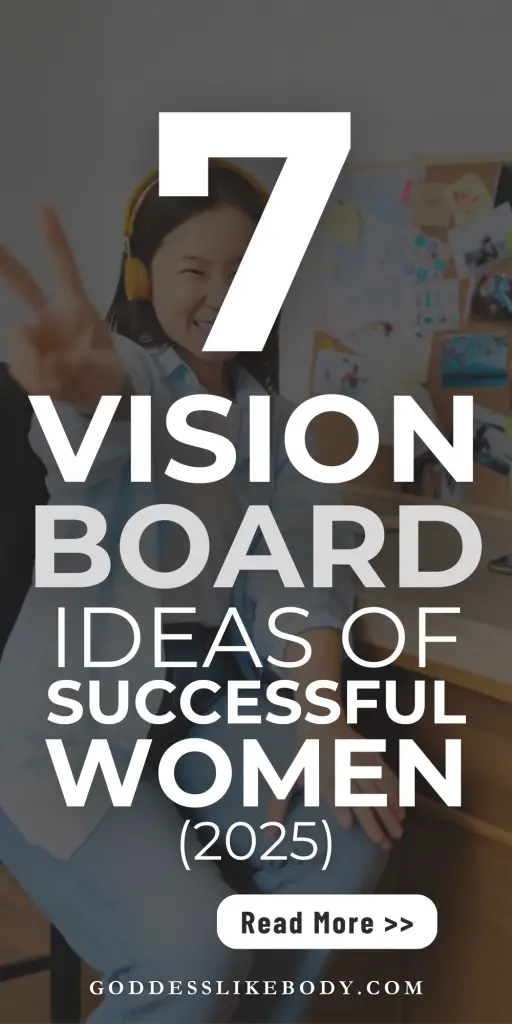People who keep looking at their goals achieve them more often. Vision boards work as daily reminders of what we want to accomplish, particularly when life gets tough.
Traditional physical boards with magazine cutouts remain popular. Digital alternatives through Pinterest and Canva have also emerged as convenient options.
This piece showcases seven tested vision board ideas from women who turned their dreams into reality through powerful visualization techniques.
These practical examples will guide your journey toward success, whether you want career advancement, financial independence, or personal growth.
Busy? Save this pin for later.
1. Why Successful Women Use Vision Boards
We’ve found interesting things about how vision boards work in our brains. Research in neuroscience shows that our brain creates impulses like those we get when performing the actual action when we picture our goals.
This explains why successful women keep using vision boards as a powerful tool to achieve their goals.
The psychology behind visualization
Our minds get programmed for success when we create and look at our vision boards regularly.
The process known as neuroplasticity shows that our brain’s neural pathways become stronger through visualization.
Then, each time we look at our vision board, we strengthen these success-oriented pathways in our minds.
Scientific evidence of vision board effectiveness
The science behind vision boards makes a strong case. Here are some notable findings:
- Students who used visualization techniques for studying achieved higher test scores
- Brain studies show that thoughts create similar mental instructions as actions
- Athletes who used detailed visualization showed better performance and faster recovery from injuries
Success rates among female executives
The numbers tell a powerful story about how vision boards help in business success:
- All but one of these five successful entrepreneurs actively use vision boards
- 82% of small business owners who used vision boards from the start achieved more than half their goals
- Vision board users were twice as confident about achieving their goals compared to non-users
A Harvard Business Study showed that the 3% of graduates who wrote down their goals (like in vision board practice) earned ten times more than the other 97% combined, just ten years after graduation.
The sort of thing I love about successful women is how they approach vision boards differently from traditional goal-setting methods.
They create boards that focus on how they want to feel and experience success instead of just material achievements. On top of that, many leave white space on their boards to allow for growth throughout the year.
Digital and physical vision boards work best when used together. A digital vision board on your phone or laptop lets you access it anytime, while a physical board in your office or bedroom creates a special space for daily visualization practice.
The TD Bank survey confirms what many of us already know – about 76% of vision board users said their actual progress lined up with their visualized goals.
This connection between visualization and achievement isn’t just by chance; it comes from how our brains process images and turn them into action.
2. The Career Accelerator Vision Board
My original vision of creating a career accelerator vision board changed the game for ambitious professionals. This powerful tool helps slice through uncertainty and connects us with our deepest professional desires.
Corporate leadership manifestation techniques
We found that there was successful manifestation in the workplace starts with clear visualization. These key techniques drive results:
- Daily visualization practice with specific outcomes
- Team-focused manifestation exercises
- Clear objective setting with visual representations
- Regular progress check-ins and adjustments
Teams that practice manifestation show better resilience and bounce back from setbacks easily. Our experience shows that adding manifestation to daily team routines promotes an environment of open-mindedness and positivity.
Business milestone visualization
Milestone visualization plays a vital role in career acceleration. Creating a well-laid-out framework that has both short-term achievements and long-term aspirations works best.
Teams that involve themselves in the manifestation process become deeply invested in their work.
Breaking down larger goals into manageable checkpoints leads to successful milestone visualization.
To cite an instance, if you aim to gain more referral partners, visualize the specific steps needed to achieve this outcome.
Professional development mapping
Professional development mapping needs a clear vision of your desired career path. Vision boards work best with SMART goals. Each professional development milestone should be Specific, Measurable, Achievable, Relevant, and Time-based.
Your career vision board should have these elements:
- Educational certifications and training programs
- Skill development milestones
- Networking and visibility goals
- Professional brand building elements
Teams who regularly practice visualization exercises show heightened input and increased efficiency. A daily visualization routine and regular progress updates create powerful momentum toward career goals.
3. The Wealth Building Dream Board
A wealth-building vision board has become my favorite way to demonstrate financial abundance. I found that visualizing financial goals makes them feel more achievable and keeps me focused on my wealth-building experience.
Financial goal visualization strategies
My experience shows that successful financial visualization needs specific strategies. A well-laid-out vision board can be a powerful tool to demonstrate wealth and financial stability. Your financial vision board should have these vital elements:
- Clear savings targets with specific numbers
- Debt-free lifestyle representations
- Emergency fund milestones
- Investment growth projections
- Retirement lifestyle images
Investment portfolio planning
A diverse investment portfolio is a vital part of long-term wealth building. The latest investment trends might look appealing, but I remind myself that investing for the long term matters most. My years of experience taught me that a smart approach has:
- Creating a plan with diverse investment products
- Focusing on compound interest benefits
- Maintaining consistent investment habits
- Setting clear portfolio milestones
Compound interest has become my new best friend in wealth building. We earn interest not just on our original savings but also on the accumulated interest. Our money grows exponentially over time.
Passive income streams visualization
Passive income stands as one of the most powerful elements of wealth building. Passive income sources need minimal ongoing effort after the initial setup. A successful passive income visualization maps out multiple streams:
| Income Type | Vision Board Elements |
|---|---|
| Rental Properties | Property photos, monthly income projections |
| Digital Products | Online course mockups, sales forecasts |
| Stock Dividends | Investment growth charts, dividend schedules |
| Online Business | Website designs, revenue targets |
The median annual passive income for households represents a key target to put on your vision board.
You can create a digital vision board using free design apps like Canva that lets you add dynamic elements like growing savings account visualizations and vacation planning for financial freedom.
Note that visualization without action won’t get you far. I review my financial vision board daily and update it as my goals evolve.
Each milestone achieved gets celebrated. This practice helps me stay focused on my long-term financial goals while staying motivated through short-term challenges.
4. The Work-Life Balance Vision Board
Life in our ever-changing world has taught me that a work-life balance vision board helps maintain sanity and success.
My experience helping professionals design their dream boards shows how this powerful tool changes chaotic schedules into harmonious lifestyles.
Time management visualization
Visual data plays a vital role in time management. Visual representations of daily routines help us spot patterns and optimize our schedules better. These visualization techniques work best:
| Time Management Element | Vision Board Implementation |
|---|---|
| Daily Routines | Morning ritual images, productivity charts |
| Work Hours | Schedule blocks, deadline trackers |
| Personal Time | Leisure activities, family moments |
| Rest Periods | Meditation spaces, relaxation goals |
Professionals who visualize their time allocation make better decisions about their schedules. Clear visual tracking helps us identify where our time goes so we can adjust accordingly.
Personal-professional boundary setting
My non-negotiable strategy for work-life harmony revolves around setting boundaries. These guidelines help maintain a healthy separation between life’s different aspects. Your vision board should include these boundary-setting elements:
- Clear working hours representation
- Dedicated family time visuals
- Personal space imagery
- Digital disconnection reminders
People without clear professional boundaries often see their personal time suffer, which leads to increased stress and fatigue. My vision board reminds me of these boundaries and helps me adjust them when needed.
Lifestyle design elements
My vision board updates reflect my evolving lifestyle goals. Research shows that keeping life and business elements separate on vision boards creates better clarity and lasting success.
A work-life balance vision board needs thoughtful inclusion of various lifestyle elements. My board always shows images of:
- Morning rituals for productivity
- Quality time with loved ones
- Personal wellness activities
- Professional achievement celebrations
- Leisure and hobby pursuits
Vision boards help clarify goals and make us think about what truly matters. The board’s daily visibility keeps me focused on building a life that values both professional ambitions and personal well-being.
5. The Digital Empire Vision Board
Building a digital empire starts with powerful visualization techniques. I found that creating a vision board for online success needs a unique approach that combines traditional visualization methods with modern digital tools.
Online business visualization
Data visualization is a vital part of building an online business. Interactive dashboards help track key performance indicators in live updates. We used these visualization techniques to:
- Track business analytics and metrics
- Monitor growth patterns
- Visualize customer experience
- Map digital transformation goals
Recent trends show that businesses using advanced visualization techniques make better strategic decisions. This has resulted in improved budget management and simplified processes across digital platforms.
Social media presence planning
A social media vision board has become essential to digital success. Vision boards help clarify specific platform goals and content strategies when paired with proper planning. Here’s how I structure my social media vision board:
| Platform Focus | Vision Elements | Success Metrics |
|---|---|---|
| Instagram/Facebook | Growth targets | Follower engagement |
| Professional brand | Network expansion | |
| YouTube | Content calendar | View time goals |
| Visual strategy | Save rates |
Success in social media depends on connecting with your vision board regularly. I suggest creating separate boards for each social platform to maintain focused growth strategies.
Digital product development
The product development process ended up needing a structured approach to visualization. My experience shows that product development involves several key stages:
- Strategic ideation and research
- Prototype development
- User interface design
- Product validation
- Launch preparation
Successful digital product visualization depends heavily on prototyping tools. These tools help create realistic representations of products before actual development. Digital rendering has transformed our product visualization by letting us:
- Create interactive experiences
- Generate high-quality visuals
- Develop immersive presentations
- Test user interactions
Dynamic product presentations substantially boost the entire development process. Digital rendering allows us to visualize and interact with projects as they progress and make adjustments in live updates.
I suggest adding augmented reality (AR) and virtual reality (VR) elements to your digital vision board.
These technologies create new possibilities for product visualization and customer engagement that make our digital dreams more tangible.
6. The Personal Growth Vision Board
Vision boards have reshaped my approach to self-improvement. They blend visualization with action steps. In fact, successful people like Oprah Winfrey credit these practices for their success and happiness.
Skill development tracking
Vision boards need a well-laid-out system to track skill development. My recommended tracking system looks like this:
| Development Area | Vision Board Elements | Review Frequency |
|---|---|---|
| Professional Skills | Certification images | Weekly |
| Creative Abilities | Project milestones | Monthly |
| Personal Growth | Achievement markers | Bi-weekly |
| Leadership Skills | Role model quotes | Daily |
Daily checks of my vision board help my brain spot opportunities I might miss. This practice has substantially improved my success rate with goals.
Mental wellness goals
Mental wellness deserves its own space on any personal growth vision board. Our brains process images 60,000 times faster than text. This makes visual elements powerful tools, especially when you have mental health goals.
These elements should be on your board:
- Mindfulness practice reminders
- Stress management techniques
- Emotional intelligence development
- Work-life balance imagery
- Personal boundary affirmations
The words we use play a significant role in stopping negative self-talk. My vision board became a powerful tool for mental wellness when I added positive affirmations and self-affirming beliefs.
Self-improvement milestones
Vision boards help define goals with precision. I take several hours to develop SMART goals – Specific, Measurable, Achievable, Realistic, and Timed. In spite of that, the process needs careful thought.
Meditation and journaling help me before I create or update my vision board. These practices clarify my true desires and purpose.
Small items that trigger positive memories or show future dreams make the board more meaningful.
My board has inspiring quotes from personal mentors and public figures. Single words or short phrases often work better than full quotes. Pick elements that deeply connect with your personal trip.
Regular reviews and updates of my vision board keep me on track. This habit makes me accountable while letting my goals adapt and grow. Strategic visualization combined with consistent reviews has boosted my success in reaching personal development goals.
7. Implementation and Progress Tracking
Success tracking with vision boards needs an organized approach that combines daily commitment with long-term monitoring. I found that using an organized approach makes a real difference in reaching our visualized goals.
Daily visualization routine
My research shows that visualization works almost as well as physical practice. We developed a powerful daily routine that gets the most out of my vision board:
- Morning review (5-10 minutes)
- Set daily intentions
- Arrange tasks with vision
- Energize with positive affirmations
- Evening reflection (5-10 minutes)
- Celebrate daily wins
- Adjust next day’s actions
- Strengthen mental imagery
Your vision board should catch your eye regularly – this is vital. The best spots in my experience are your nightstand, home office, or near your television.
Monthly goal review process
Vision boards need regular attention, just like a garden. My monthly reviews have these components:
| Review Area | Action Items | Frequency |
|---|---|---|
| Goal Progress | Track milestones | Monthly |
| Vision Alignment | Update images/words | Quarterly |
| Success Metrics | Measure KPIs | Weekly |
| Action Plans | Adjust strategies | Monthly |
Yearly measures make progress easier to track and understand. This organized approach helped me keep momentum throughout the year.
Success metrics tracking
A detailed tracking system works alongside regular reviews. Research shows that vision boards with proper tracking can substantially improve goal achievement. My tracking framework has:
- Key Performance Indicators (KPIs)
- Quantifiable goals progress
- Milestone achievements
- Timeline adherence
- Progress Documentation
- Monthly achievement logs
- Photographic evidence
- Journal entries
- Adjustment Protocols
- Quarterly strategy reviews
- Resource allocation assessment
- Timeline modifications
A shared dashboard displays clear and reliable data. This method is a great way to get accountability and stay motivated.
The largest longitudinal study showed that vision boards need regular updates to work. My structured review cycle looks like this:
- Daily Involvement (90 seconds minimum)
- Quick morning review
- Evening reflection
- Energy alignment check
- Weekly Assessment (15-30 minutes)
- Progress evaluation
- Action plan adjustment
- Next week planning
- Monthly Deep Review (1-2 hours)
- Full progress review
- Goal alignment check
- Strategy refinement
- Quarterly Overhaul (3-4 hours)
- Major milestone evaluation
- Vision board updates
- Long-term strategy adjustment
A balanced scorecard helps cover every aspect of our strategy from multiple angles. This detailed approach will give a full picture of real progress toward our visualized future.
My most effective tracking method has:
- Clear Objective Setting
- Specific goal metrics
- Timeline measures
- Success indicators
- Progress Monitoring
- Weekly check-ins
- Digital tracking tools
- Physical progress journals
- Performance Analysis
- Data interpretation
- Pattern recognition
- Strategy adjustment
- Success Celebration
- Milestone acknowledgment
- Achievement documentation
- Motivation reinforcement
Teams and individuals who regularly use their vision boards show substantially higher efficiency levels. The secret lies in staying organized while being flexible enough to adapt to changes.
A dedicated tracking journal should include:
- Daily Progress Notes
- Quick wins
- Challenges faced
- Solutions implemented
- Weekly Summary Reports
- Key achievements
- Obstacle analysis
- Strategy adjustments
- Monthly Performance Reviews
- Goal progression
- Resource utilization
- Future planning
This organized approach to tracking helped me stay focused and motivated throughout my experience. Regular visualization combined with structured progress monitoring creates a powerful system that turns vision board dreams into reality.
Conclusion
Vision boards work as powerful tools to achieve success in all kinds of life situations. My research and experience show how mixing scientific visualization techniques with practical strategies guides to remarkable results.
Research proves that people who use vision boards reach their goals more often than those who don’t.
Success comes from daily participation with your vision board and a structured tracking system.
This applies whether you want to grow your career, build wealth, balance work and life, create a digital empire, or develop personally. The combination of consistent visualization and concrete steps makes it work.
The best method I’ve found mixes physical and digital vision boards. This gives you both a tangible connection and easy updates.
Your vision board stays lined up with your changing goals through regular reviews and adjustments.
It also helps to track specific metrics that keep momentum going and let you celebrate wins along the way.
Note that vision boards do more than just look pretty – they program our brains to succeed. Pick one area to focus on, use the strategies shared in this piece, and watch your visualized dreams become reality.











Leave a Reply
You must be logged in to post a comment.